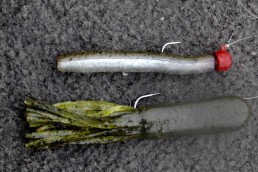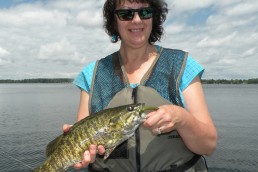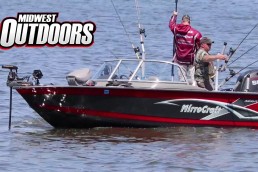Fishing a Ned Rig: Crackling a Ned Rig
SHARE THIS POST
Dave Mull’s Ned Rig Fishing Tips
When an angler first ties on a classic Ned rig, a 2.75-inch TRD worm-shaped plastic lure rigged on a jighead, he or she likely will assume that it should be fished like a worm. They drag, lift-drag or hop it along on the bottom. More often than not, they catch fish with this low-and-slow method.
“I call it a ‘sandwich lure,’” says my friend and fellow writer Barb Carey, who heads the Wisconsin Women Fish organization. “Cast it out. Eat a half sandwich and then move it a little. Eat the other half sandwich and move it a little more. If someone complains they can’t catch fish on a Ned rig, I tell them they’re probably not fishing it slowly enough.”
No doubt Barb, an angling expert in her own right, is correct. In many, many situations, dragging or hopping a TRD—which stands on its nose and looks like a feeding or dying minnow—is the best way to go.
But slow is not the only way to go to effectively catch fish with these little baits.
Putting a bit more speed behind your presentation
Many anglers are learning just how effective the small lures are when swum, snap-jigged or ripped-and-reeled. You can actually fish them quite quickly and get reaction strikes, just like you can do with a spinnerbait or jerkbait. A diminutive, open-hook Ned rig zipping through a bass’s strike zone often gets eaten, plain and simple.
Learning this technique can help any angler cover water and catch fish when they’re aggressive, or even when they’re in a post-cold-front funk. Just zip it by a fish’s face.
Once again, try to put yourself in the bass world. Imagine what it would be like to encounter a finesse lure, fished quickly, from the fish point of view. Just as a flashy spinnerbait buzzed into a fish’s strike zone can often provoke a strike, so can a quickly moving piece of plastic with a minnow profile. When you snap-reel a TRD on a 1/15- to 1/10-ounce jig by a fish, that fish gets to see something that looks like a minnow darting through its strike zone. It has a split second to commit. Since a Ned rig can look so much like a minnow, the fish often does strike the meal that just came into its ambush zone.
In fact, two of the six retrieves Ned Kehde has categorized as top Midwest Finesse retrieves with a Ned keep it moving and off the bottom. One is the “Swim, Glide and Shake,” and the other is the “Straight Swim.”
Both of those are great ways to cover water. They’re pretty much done with the rod tip close to the water surface, reel handle turned just fast enough to keep the lure off bottom or at close to the same depth. These retrieves are easy to do and effective.
Cracking a Ned-How to Fish a Ned Rig
I don’t know what to call this retrieve, but the end effect is to have a Ned start to sink, then zip forward about a foot. It can touch bottom, but, most often, it doesn’t. It works anywhere—over weeds, down the middle of channels—anywhere bass or other target species might be. In fall, it is particularly effective on shallow flats, say 4 to 8 feet deep, with scattered weeds or rocks. Bass, pike and other predators wander these flats looking for crayfish, minnows, young bluegills and perch—any living protein that they can get their lips around.
So, follow this sequence carefully. Start way upwind on the flat. Let any wind push you, whether you’re in a boat or a kayak. Sometimes, in strong wind, a bucket or drift sock deployed can slow you down and let you cast a good ways downwind. The straighter you can cast downwind, the better, as the breeze won’t put more of a bow in your line. Cast as far as you can, flip the bail of your spinning reel and reel until there’s about a foot of slack in your line. Now, with the rod horizontal to the water, use your elbow to snap your rod tip so it moves about two feet, taking up a foot of slack before the line comes tight with the lure and moves the lure about a foot.
Basically, you’re pulling the rod tip two feet, pulling a foot of slack tight before pulling the lure itself a foot. The lure, sinking slowly if not suspending, spurts forward about a foot, then starts to sink slowly again. Keep this two-foot-jerk sequence going.
Are you enjoying this post?
You can be among the first to get the latest info on where to go, what to use and how to use it!
You rarely feel a bite. Fish almost always smack the lure when it starts to sink. You’ll just feel some weight when you pull that rod tip two feet. When you do, start reeling fast to load your rod and hook the fish.
I use a medium-light, 7-foot spinning rod, a relatively inexpensive Shimano Convergence, for almost all Ned rig fishing. This rod shines for cracking a Ned like this.
The basic TRD or any other three-inch plastic on a 1/16- to 1/8-ounce head works for this, as do other lures. Since you usually want the lure to pause and not plummet to the bottom, the unsalted, more buoyant lures, such as the Finesse ShadZ, work well as does a 3-inch MinnowZ. You can pair either one with a heavier 1/10-ounce ShroomZ or NedLockZ head. Jade’s Jigs (417-841-7997) has a 3/32-ounce bismuth-tin jighead with a sickle hook that works great with these lures, too.
One of my favorite lures is half a 7-inch Finesse WormZ from Z-Man, the tail sliced horizontally. I think it provokes strikes because it makes some noise. Z-Man ElaZtech baits
Noisy soft plastics
So, this is one of those things I discovered while playing with lures in the bathtub. I wasn’t taking a bath and playing with lures. Honest. I wanted to see the action of the old, 2-inch worm once sold by the now-defunct Toledo Tackle Company, which used to be in Many, La. It was the first real “finesse” lure I ever used for bass, way back in the 1980s.
Anyway, I was in Michigan, in the middle of winter. And, well, I don’t recall why I was on my knees watching the action of a small worm in our family bathtub, but here’s what I learned. A small, 2-inch worm, rigged so its flat tail is horizontal, actually makes a noise loud enough that you can hear it, if you’re close to the water surface.
Seriously. It makes a “Thwip!” sound, if you jerk it upwards a few inches. Not super loud, but if a human can hear it above the water surface, you have to know that a bass in the water can hear it, too. No doubt the fish can feel the vibration that flat tail with its lateral line creates.
With the original 2-inch worms now nearly lost to history (two of my buddies have some, and I plan to mooch), you can still get some extra sound by cutting the Finesse WormZ tail. The plastic slaps together a bit and moves water much like the flat tail of the old 2-inch worm did.
Ned Rig Fishing Tip
Lots of jigheads now feature a keeper embedded in the lead or bismuth-tin head that holds plastic well. With Z-Man ElaZtech baits, however, these keepers are a pain. It takes a while to stretch the tough ElaZtech over the big hook of the keeper and get your bait nice and straight on the hook shank. I got tired of trying last summer, and, frustrated, just mashed the keeper flat with pliers. The TRD was easy to rig and, surprisingly, the keeper still kept the soft plastic’s nose flush to the jighead.
So, this fall, don’t bother bringing sandwiches along to gauge how fast you need to fish your Ned rigs. Cast and crack to cover water and, most likely, catch a bunch of fish.

MWO
SHARE THIS POST
Did you enjoy this post?
You can be among the first to get the latest info on where to go, what to use and how to use it!
Dave Mull
Dave Mull of Paw Paw, Mich. has spent his career communicating the outdoors experience and runs Inner Viking Media. He enjoys kayak fishing for anything that swims in the lakes and rivers of the Midwest and beyond, and even uses his MirroCraft, from time to time. Available for seminars.


